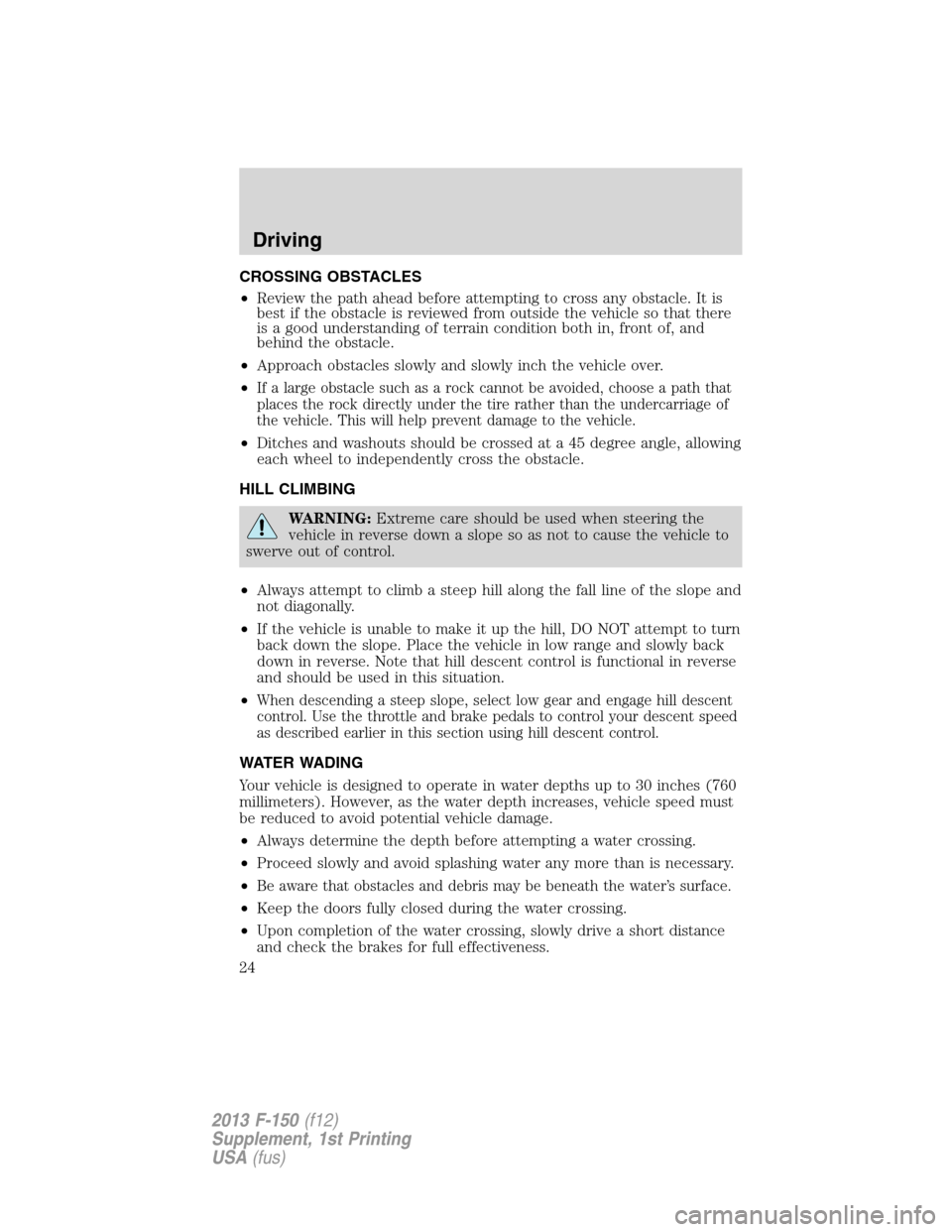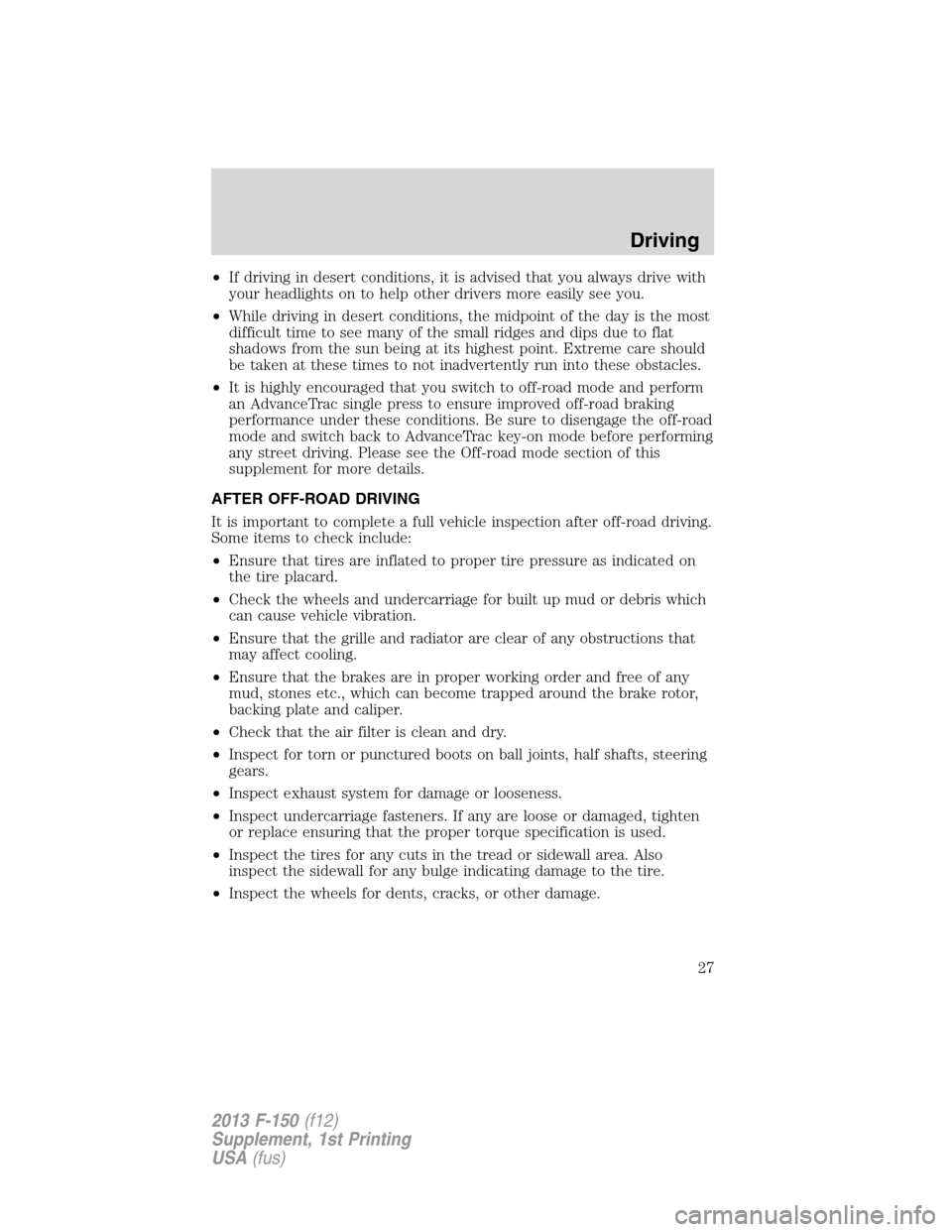Page 15 of 39

HILL DECENT CONTROL
WARNING:Hill descent control does not provide hill hold at
zero mph (0 km/h). When stopped, the parking brake must be
applied and/or the vehicle must be placed inP(Park) or it may roll
away.
Hill descent allows the driver to set and maintain vehicle speed while
descending steep grades regardless of surface conditions.
Hill descent control can maintain vehicle speeds on downhill grades
between 2 and 20 mph (3 and 32 km/h). Between 20 and 40 mph (32
and 64 km/h), the system remains enabled, but descent speed cannot be
set or maintained. If vehicle speed is above 40 mph (64 km/h), the
system is disabled. After this point, vehicle speed must drop below
40 mph (64 km/h), and the hill descent control button must be pressed
again to engage the feature.
Hill descent control requires a cooling down interval after a period of
sustained use. The amount of time that the feature can remain active
before cooling varies with conditions. The system will provide a warning
in the information display screen and a chime will sound when the
system is about to disengage for cooling. At this time, manually apply the
brakes as needed to maintain descent speed.
Enabling Hill Descent Control and Setting the Descent Speed
1. Press and release the hill descent
button located on the center
console. A light on the button will
illuminate and a one second chime
will sound when this feature is
activated.
2. To increase descent speed, press the accelerator pedal until the
desired speed is reached.
3. To decrease descent speed, press the brake pedal until the desired
speed is reached.
Driving
14
2013 F-150(f12)
Supplement, 1st Printing
USA(fus)
Page 25 of 39

CROSSING OBSTACLES
•Review the path ahead before attempting to cross any obstacle. It is
best if the obstacle is reviewed from outside the vehicle so that there
is a good understanding of terrain condition both in, front of, and
behind the obstacle.
•Approach obstacles slowly and slowly inch the vehicle over.
•
If a large obstacle such as a rock cannot be avoided, choose a path that
places the rock directly under the tire rather than the undercarriage of
the vehicle. This will help prevent damage to the vehicle.
•Ditches and washouts should be crossed at a 45 degree angle, allowing
each wheel to independently cross the obstacle.
HILL CLIMBING
WARNING:Extreme care should be used when steering the
vehicle in reverse down a slope so as not to cause the vehicle to
swerve out of control.
•Always attempt to climb a steep hill along the fall line of the slope and
not diagonally.
•If the vehicle is unable to make it up the hill, DO NOT attempt to turn
back down the slope. Place the vehicle in low range and slowly back
down in reverse. Note that hill descent control is functional in reverse
and should be used in this situation.
•
When descending a steep slope, select low gear and engage hill descent
control. Use the throttle and brake pedals to control your descent speed
as described earlier in this section using hill descent control.
WATER WADING
Your vehicle is designed to operate in water depths up to 30 inches (760
millimeters). However, as the water depth increases, vehicle speed must
be reduced to avoid potential vehicle damage.
•Always determine the depth before attempting a water crossing.
•Proceed slowly and avoid splashing water any more than is necessary.
•
Be aware that obstacles and debris may be beneath the water’s surface.
•Keep the doors fully closed during the water crossing.
•Upon completion of the water crossing, slowly drive a short distance
and check the brakes for full effectiveness.
Driving
24
2013 F-150(f12)
Supplement, 1st Printing
USA(fus)
Page 28 of 39

•If driving in desert conditions, it is advised that you always drive with
your headlights on to help other drivers more easily see you.
•While driving in desert conditions, the midpoint of the day is the most
difficult time to see many of the small ridges and dips due to flat
shadows from the sun being at its highest point. Extreme care should
be taken at these times to not inadvertently run into these obstacles.
•It is highly encouraged that you switch to off-road mode and perform
an AdvanceTrac single press to ensure improved off-road braking
performance under these conditions. Be sure to disengage the off-road
mode and switch back to AdvanceTrac key-on mode before performing
any street driving. Please see the Off-road mode section of this
supplement for more details.
AFTER OFF-ROAD DRIVING
It is important to complete a full vehicle inspection after off-road driving.
Some items to check include:
•Ensure that tires are inflated to proper tire pressure as indicated on
the tire placard.
•Check the wheels and undercarriage for built up mud or debris which
can cause vehicle vibration.
•Ensure that the grille and radiator are clear of any obstructions that
may affect cooling.
•Ensure that the brakes are in proper working order and free of any
mud, stones etc., which can become trapped around the brake rotor,
backing plate and caliper.
•Check that the air filter is clean and dry.
•Inspect for torn or punctured boots on ball joints, half shafts, steering
gears.
•Inspect exhaust system for damage or looseness.
•Inspect undercarriage fasteners. If any are loose or damaged, tighten
or replace ensuring that the proper torque specification is used.
•Inspect the tires for any cuts in the tread or sidewall area. Also
inspect the sidewall for any bulge indicating damage to the tire.
•Inspect the wheels for dents, cracks, or other damage.
Driving
27
2013 F-150(f12)
Supplement, 1st Printing
USA(fus)